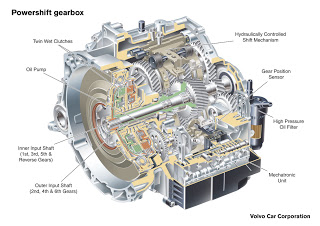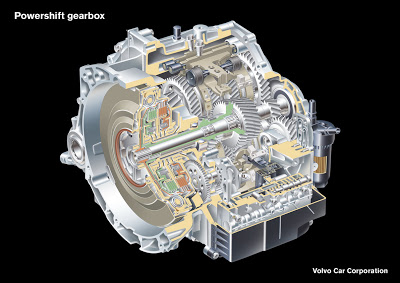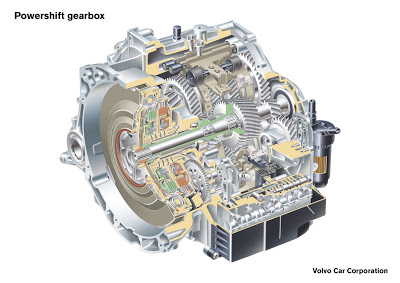Volvo Gets Its Own DSG Transmission
 The Swedes are joining in the dual-clutch semi-auto gearbox craze that began with the VW group’s highly acclaimed DSG with the official presentation of the “Powershift†transmission. Developed in cooperation with Getrag, Volvo’s dual-clutch 6-speed tranny is similar in design with VW’s first generation DSG gearbox meaning that the clutches are immersed in oil, and don’t run "dry" like the second gen 7-speed DSG II (see here). According to the Swedes, the Powershift not only changes gears significantly faster and smoother than a conventional automatic transmission, but it also cuts fuel consumption by about 8 per cent.
The Swedes are joining in the dual-clutch semi-auto gearbox craze that began with the VW group’s highly acclaimed DSG with the official presentation of the “Powershift†transmission. Developed in cooperation with Getrag, Volvo’s dual-clutch 6-speed tranny is similar in design with VW’s first generation DSG gearbox meaning that the clutches are immersed in oil, and don’t run "dry" like the second gen 7-speed DSG II (see here). According to the Swedes, the Powershift not only changes gears significantly faster and smoother than a conventional automatic transmission, but it also cuts fuel consumption by about 8 per cent.The version of Powershift that Volvo is now launching is dimensioned to handle torque levels up to 450 Nm. Initially, the dual-clutch gearbox will be offered exclusively on the Volvo C30, S40 and V50 models fitted with the 2.0-litre four-cylinder turbodiesel which delivers a power output of 136 hp and 320 Nm of torque. -Details after the jump

 Press Release
Press Release
Volvo Cars launches Powershift - Two Transmissions in One
- Fully-automatic and sequential six-speed transmission
- Twin wet clutches give extremely fast and smooth changes
- About eight percent lower fuel consumption
- Optimised for powerful diesel engines
Two-litre turbodiesel versions of the Volvo C30, S40 and V50 are now also available with a fully-automatic transmission. This new Powershift transmission is a six-speed unit. It features twin wet clutches that provide gearchanging comfort on a par with that of a fully-automatic transmission, yet with the performance one expects of a manual gearbox. What is more, it significantly cuts fuel consumption compared with a conventional automatic transmission.
The Powershift transmission has been developed by Volvo Cars in cooperation with its transmission partner Getrag. Powershift operates in principle as two parallel manual gearboxes. It has twin wet clutches that work independently of one another. One clutch controls the odd gears (1, 3, 5 and reverse) while the other handles the even ratios (2, 4 and 6). The two clutches operate alternately, with one engaging while the other disengages. This means that at the same time as the engine gets full power and maximum thrust in first gear, second gear is placed in readiness to be engaged. And when second gear has been engaged, third gear is readied, and so on. This promotes a continuous flood of power without any disruption in power delivery or any torque loss, resulting in extremely fast and silky-smooth gearchanges while maintaining acceleration throughout the gearchanging process.
Eight percent lower fuel consumption than a conventional automatic transmission
Apart from gearchanging comfort and high performance, Powershift contributes to noticeably lower fuel consumption.
"According to our measurements, Powershift contributes to a fuel consumption saving of about eight percent compared with a conventional automatic transmission," says Magnus Jonsson, Senior Vice President, Research & Development, Volvo Cars. "And that is an important benefit in the hunt to keep lowering the negative impact on the environment."
The Powershift function is based on the technology used in a manual gearbox but with the difference that the two wet clutches are each linked with their own input shaft. One shaft spins inside the other. The inner shaft regulates the output shaft for first, third, fifth and reverse gears, while the outer shaft controls second, fourth and sixth gears. The clutch function is operated by an electro-hydraulic control unit that ensures that one clutch is shut while the other is open, and vice versa.
Each clutch functions like a slip clutch. A piston pushes a number of clutch plates against each other and locks them together through the resultant friction.
Automatic or sequential gearchanging without any loss in torque
Powershift gives the driver an automatic transmission that permits sequential gearchanges, just like with Volvo's Geartronic transmission. The difference is that with Powershift even manual gearchanges take place without any time or power losses.
Since Powershift, unlike a conventional automatic transmission, does not need a torque converter, planetary gears or multiple wet clutches, there is also none of the added torque losses that these features bring.
Optimal choice for powerful diesel engines
Thanks to the use of twin wet clutches, the Powershift transmission can handle high torque levels and in principle has no limitations on choice of ratio. This makes it an ideal partner for today's modern, powerful diesel engines.
The version of Powershift that Volvo is now launching is dimensioned to handle torque levels up to 450 Nm. In the versions of the Volvo C30, S40 and V50 in which it is fitted, Powershift is mated to the 2-litre four-cylinder turbodiesel which delivers a power output of 136 hp and 320 Nm of torque.
"With Powershift we can now offer automatic transmission with our two-litre diesel engine," says Magnus Jonsson. "And it's not just any old automatic transmission: lower fuel consumption allied to increased comfort and higher performance sounds like an impossible equation. But with Powershift we have shown this is perfectly possible."
- Ford Updates Kuga With New 2.0-liter Diesel Engines And Individual Trim
Following hot on the heels from the introduction of the refreshed for the 2011MY Mondeo, Ford's European arm is now broadening the appeal of its Kuga SUV with the presentation of two new diesel engines coupled with a new 'Individual' trim....
- Ford Announces New 2.0 Turbo Engine With 203hp For Mondeo And 163hp Diesel For Kuga Suv
Along with the Euro-spec 2011 Focus, the final versions of the C-MAX and Grand C-MAX which go on sale in Europe this year and some updates to the optional equipment of the recently revealed S-MAX and Galaxy facelift, Ford will also unveil the 2010 model...
- Volvo Launches New 203hp 2.0-liter Turbo Gasoline Engine For S80, V70 And Xc60
FoMoCo's soon-to-be-sold to China's Geely Motors Volvo brand is expanding its range of gasoline engines with the presentation of the all-new 2.0-liter GTDi (Gasoline Turbocharged Direct Injection) that will initially find its way under the hood...
- Ford Focus & C-max With Dual-clutch Gearbox On Sale In The Uk
Ford’s new six-speed dual clutch semi-automated gearbox is available for order in the UK. Called PowerShift, the transmission is offered on the Focus and C-MAX (minivan version of the Focus) range with the 2.0-litre TDCi diesel engine. Buyers can...
- 2008 Volvo C30 Efficiency: 4.5l/100 Km Or 52.3 Mpg
Who needs hybrids? Apparently Volvo doesn’t as it proves with the new C30 Efficiency (available from early 2008) which boasts an avg. fuel consumption of less than 4.5 l/100 km (or more than 52.3 mpg). That’s compared to 4.9 l/100 km which...
